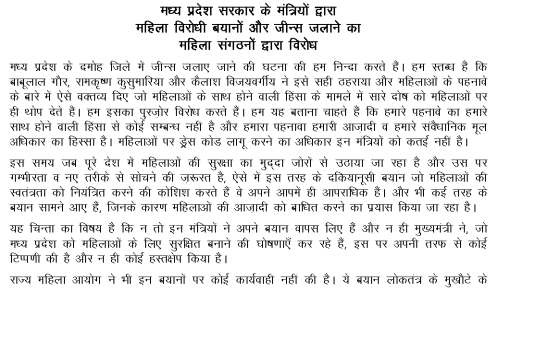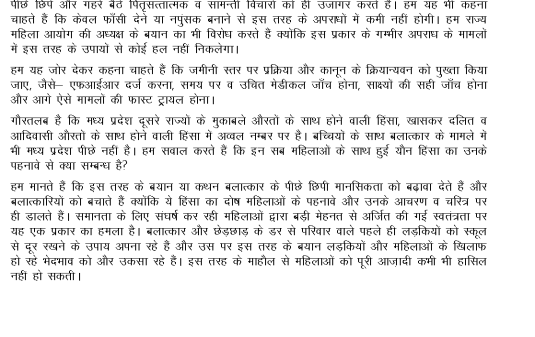December 31, 2012, sarai.net
By Saroj Giri
‘National shame’, lajja – this is the sentiment most Indians feel, now that the raped girl has died. The rape has so far been essentially portrayed as a heinous but aberrant crime, a deviant behavior which apparently did not follow from the kind of society we inhabit. So, why should we, the entire society, feel the shame? This only means that shame has burst through exposing all the denials and attempts to contain the enormity of the problem and just make it a case requiring strong laws. Shame has come upon Indian society in spite of itself. Society as a whole stands implicated – this is what the sentiment of shame entails.
Shame, said Marx, is a revolutionary sentiment. Shame is introspective, loosens the inner resistance one can put up against looking into oneself. Now Indians might be willing to look into their society, their family, their institutions, their day to day life, their values, their civilization, their ethos, their human relations – and locate the recesses of patriarchal domination in them all. Indian society today, that real society where violence against women is normal, almost casual, and where love towards women is deeply patriarchal, seems to have loosened itself up a bit. It appears far less confident about its claims, its self-lauding proclamations. Its defences are down – a rare occasion. It is caught offguard today. It cannot act as though violence against women is only an external problem, exceptional and a deviation from ‘our’ social norms.
When Frantz Fanon revealed the horrors of French colonialism, Sartre pointed out that the French, even the liberal and humane ones, should feel shame. Feel ashamed. Similarly instead of pointing the fingers to this or that minister or the police or some such particular agency or authority as responsible for rape, society should open itself up for introspection. What will be revealed is simple: an out and out patriarchal society, male domination and female subjugation.
This shame has forced a realization even in the mainstream media. Here is the Times of India: “The Delhi gang-rape victim succumbed to her injuries at a Singapore hospital on Saturday morning. The death of 23-year-old Nirbhaya (a name given to her by TOI) not only leaves us sad and heightens our sense of outrage, but also makes it important for all of us to focus now on the real reason behind her agony — the lack of respect for women in our patriarchal society” (Dec 30, 2012).
‘Lack of respect for women’, ‘patriarchal society’ – the right noises are being made. The right noises are being heard. From this ‘real reason’ of course the media being media goes on to suggest that people take a pledge to individually refrain from engaging in violence against women. There is a problem here. For this ‘pledge thing’ again tries to turn the focus away from the internal power relations that constitute this society, the relations of domination through which most men relate to women in this society.
So people are introspecting. They are on their own making all the connections – putting two and two together. They seem to be secretly sensing that the capital punishment and death to the rapists will only serve to shield society, cover up its true character. ‘India’s daughter’ precipitated a process where the accusing finger can also slowly turn towards ‘India’. Every family, every bastion of patriarchy, every woman within the family, every ‘victim’ of patriarchy, is following ‘the news’ – and getting inspired to raise new questions and not just provide ready solutions about ‘preventing rape’.
‘India Rising’
So the question: will shame be the signage, the starting point for the movement against patriarchy? Or will it be, in the name of ‘fighting rape’, another addition to the Indian nation’s list of ‘fighting untouchability’, ‘fighting poverty’, ‘fighting communalism’.
Indeed ‘fighting rape’ might, I fear, soon enter the lexicon of the ‘tough administrator’ Narendra Modi vying to be Prime Minister. In surmising this I thought I was only being a slightly paranoid leftie – till I saw some placards at the protests.
Stop Sexual Terrorism, it said. Rape as sexual terrorism, like a bomb blast! Rape is here externalized, like terrorism from across the borders, an evil enemy which attacks your good society.
I can already hear those like Chetan Bhagat saying how this is ‘new India rising’ – how the youth are not willing to take all this lax laws and all this disruption of life in a decent society, this kind of barbaric treatment of our upwardly mobile women. ‘New India’, ‘India Rising’, by invoking the hyperbole of capital punishment against rape, secretly reinscribes the myth of an essentially good society – ‘Indian values’. After anti-corruption, is ‘fighting rape’ the new cause of the self-righteous, self-aggrandising upper middle classes? This moment of shame will provide the long overdue antidote to the self-righteous middle classes and at least lessen their confidence and aggression, slow them down.
The initial outrage
The protests however were initially not in a mood to feel this shame, not in a mood to introspect. They started off dominated by the feeling of outrage.
Outrage has a target – Shiela Dixit, the Home Minister, Delhi Police, private bus operators. It functions with an accusing finger towards something external. It is essentially non-introspective. To start with, the protests against rape had this basic tendency to regard rape as having nothing to do with the patriarchal power relations that constitute society. Instead rape is located in something external, external to an essentially good society – it is a deviation, a crime, a criminal act to be explained by say the rapist’s ‘psychology’ but not by the tissue of social relations. Rape as a result of a criminal and sick mindset rather than what would follow from the gendered power relations that constitute this society we inhabit.
So the ‘prevention of rape’ does not involve transformation of society. It can be achieved by delegating responsibility to an authority which stands at a remove from society. So ministers and police must fix this problem for the smooth functioning of this society. This delegation meant exoneration of society, of precisely that society where patriarchy is felt and sensed every moment. Rendering this society invisible! To achieve this feat, it had to generate its own histrionics, high drama, extreme emotions, extreme everything – the smokescreen of ‘death to the rapists’. ‘Hang the rapists’ and leave society as it is – this is the motto. The mythical good society must be left unquestioned.
So here violence against women is not always already happening, not already foretold. It ‘takes place’. It is an incident – when, where, who. This is the way violence against women is rendered contingent, exceptional, forever an aberration – it just so happened. It took place on that night of Dec 16th 2012. It takes place every other day, or the same day some other place, or perhaps every hour – but each is a separate case. Each can be explained by referring to the ‘background’ of those individuals involved. ‘They were from the slum area’. The bus in which the girl was travelling did not have proper licenses. They were ‘those types’.
Society here sits as the judge and takes the moral high ground – it exonerates itself. What is rendered invisible is the thousand and one ways in which the rape and violence against women are mandated by ‘society’ – from female infanticide, to bride burning, to dowry deaths, to sexual harassment, to getting groped in the metro, to rape within marriage, to honour killings… The list is endless. Not just the violence – even the love and care reserved for women is laden with inscription of male power. The ideal wife, the ideal daughter, the respectable woman, adarsh bharatiya nari, the super mom – these are notions, tendencies and inclinations that constantly push women towards precarity, a lack of confidence, a fear, an anxiety. These are indeed sometimes more dangerous than the committed ‘crimes’.
So the outrage overlooked all of this. And yet this outrage gave way to shame. This shame might inspire a movement which could irrigate the veins and arteries of resistance against patriarchy in the street, in the family, in the bedroom. It might lead to social critique. It might allow women to go beyond merely fighting for basic safety and security. It might, indeed must, allow them to freely assert their powers and desires, their thoughts and their sexuality.
Today women are on the defensive, seeking to be the beneficiaries of protection accorded by an essentially male dominated society. This is extremely infantilizing. Even if this movement might succeed this might not change. In fact it might actively contribute to this infantalising – women might be ‘safe’ and infantilized. For example, if Delhi Police gets better in protecting women from sexual attacks then will women also be obliged to follow some of the ‘do’s and don’ts’ put up by the police? Will this enhance or lessen women’s agency?
Social evil?
So how will this shame be mobilized? Should feminists now work with the government to help make good laws? Feminists might proceed by laying the statistics of so many other kinds of violence against women: bride burning, dowry deaths, sexual harassment and so on. Feminists might provide the inputs to good policy formulation. But will these inputs only mean that in this era of targeted policy making, patriarchy would start getting ‘measured’ in terms of ‘affected groups’ or stake-holders and the benefits they should get? If we demand so much protection from the police, then will women also be obliged to abide by some of the rules ‘for your own safety’ that Delhi Police might frame?
Too many voices are calling for ‘strong laws and speedy justice’ to deter rapists, a call for a strong state. Perhaps a technocratic or security-centric solution is in the offing. If not this, another bad option that might impose itself is to adopt an approach of something like ‘the unfinished task of social reform’ carried over from the 19th century. So, like fighting sati, or widow remarriage, or untouchability, violence against women will be identified as a social evil. Yes it is a ‘social evil’. But is violence against women, like untouchability, a malignant growth in an otherwise healthy ‘social body’, as Gandhi would have it? Or is it intrinsic to the ‘social body’?
It is not to a cool and calm deliberation for policy formulation that this shame must lead to. What we need is a much more enriched rage, now carrying the moment of shame, of social critique. The narrow focus of the rage – ministers, police, strong laws – must now give way to taking account of how this rage must also be directed against the manner in which rape and violence against women is routinely deployed by none other than the state itself. Just check out the reports coming from the North East, in Kashmir and elsewhere. Or the rape of over 30 women by the Rajasthan Rifles in Kunan Poshpora. Or the gruesome rape and murder of Dalit women in Khairlanji. This list is very long. These are neither the result of an exception, bad policing nor a social evil. It is instead a well calculated strategy to inscribe the power of the state through patriarchal violence.
Related articles
- #India- Blind to what, Your Honour? #Vaw #Judiciary (kractivist.wordpress.com)
- Radical Socialist Statement on the #Delhigangrape and Popular Protests (kractivist.wordpress.com)
- Rape Culture, Capitalism and India (kractivist.wordpress.com)

















